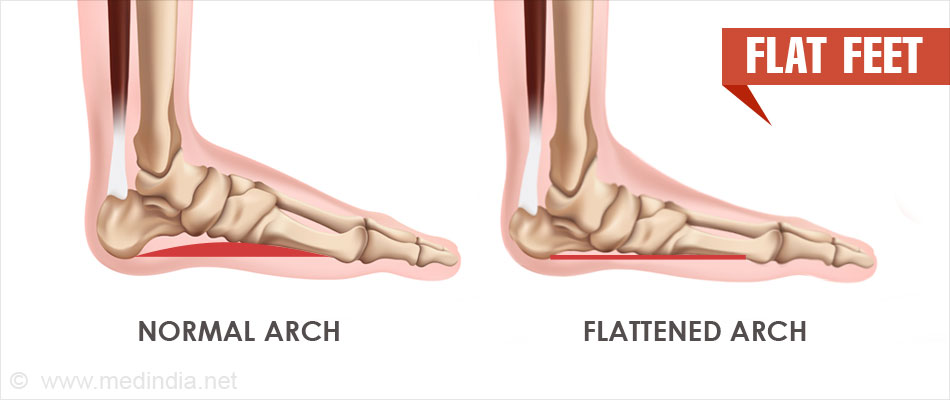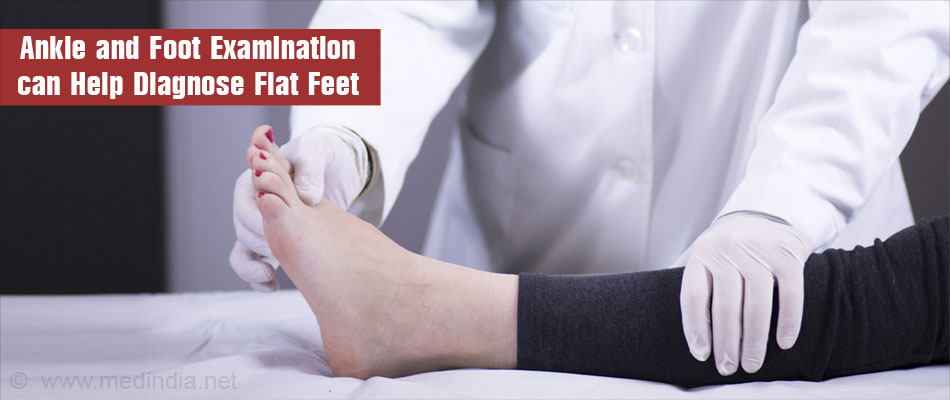- About Flatfeet - (http://www.mayoclinic.org/diseases-conditions/flatfeet/basics/treatment/con-20023429)
- Sun PC, Shih SL, Chen YL, et al. "Biomechanical analysis of foot with different foot arch heights: a finite element analysis". Comput Methods Biomech Biomed Engin. 2012;15(6):563-569.
- Adult Acquired Flatfoot - (http://orthoinfo.aaos.org/topic.cfm?topic=a00173)
- The feet of overweight and obese young children: are they flat or fat? - (http://www.ncbi.nlm.nih.gov/pubmed/17135610)
- Flat feet - (https://www.nlm.nih.gov/medlineplus/ency/article/001262.htm)
- Flexible Flatfoot - (http://www.foothealthfacts.org/footankleinfo/flatfoot.htm)
What is Flatfeet?
Flat feet is a condition also referred to as Pes Planus, or fallen arches. It is a complex deformity and occurs when the entire sole is in near contact with the ground while standing, that is, there is no arch to the foot.
The arches add elasticity and flexibility to the foot and are very important for proper foot movement. A fallen arch may cause intense foot pain in your feet, ankles, and lower leg muscles.

What are the Types of Flat Fleet?
There are two types of flatfeet, flexible flat feet (FFF) and rigid flat feet (RFF).
Flexible flat feet (FFF) is sometimes also called "pediatric flatfeet" because it is first apparent in childhood. FFF most often occurs due to weak ligaments that connect the bones of the foot together, or due to muscle or tendon weakness. Flexible flat feet is usually present in both feet. The arch is absent in the standing position, bur re-appears when the foot is in any other position.
Rigid flat feet (RFF) When a rigid flatf oot develops in adults, it is called "adult acquired flat foot". RFF develops because of the weakening of the tibialis posterior muscle tendon, which is a major supporting structure of the foot arch. It leads to flattening of the arch and rolling in of the ankle. It is a progressive deformity and early symptoms include pain and swelling on the inside of the foot. It may eventually lead to arthritis.
What are the Causes of Flat Feet?
Flat feet may occur as a result of wear and tear of the tissues holding the joints in the foot, called ligaments and tendons. In some children, the arches may fail to develop The common causes of flat feet include the following:
- Standing or walking for long periods, especially while wearing high heels.
- People with very flat feet or high arches are prone to plantar fasciitis bunions
- Weakened muscles in the foot, ankles, and lower leg due to aging.
- An abnormality in the foot that is present from childhood.
Conditions that predispose to the development of flat feet are:
- Rheumatoid arthritis
- Diabetes
- Aging
- Pregnancy
- Nerve problems or muscle diseases- such as cerebral palsy, muscular dystrophy, or spina bifida.
- Obesity

What are the Symptoms and Signs of Flat Feet?
Many people have flat feet but they generally go un-noticed and do not cause any symptoms. Such patients may not require treatment. The most common symptoms of flat feet include the following:
- Painful or achy feet, especially around the areas of the arches, heels and ankles. The pain often occurs after long periods of standing or playing sports.
- Swelling of the inside part of the sole.
- Certain foot movements such as standing on toes become difficult.
- Lower back and leg pain due to a weakened posture and discomfort through a person’s hips and lower back.
How do you Diagnose Flat Feet?
The diagnosis of flat feet is made based on the following:
- The health history of the patient is evaluated for evidence of any illnesses or foot problems that may be linked to flat feet
- Physical examination of the feet. The feet are observed for the formation of the arch with toe standing, which may indicate flexible flatfoot, or the appearance of pain while standing or walking. The soles of the shoes are checked for any unusual wear patterns.

The following tests may be needed in some cases:
- CT scan to evaluate the bones of the feet for any abnormality.
- MRI scan to look at the soft tissues like ligaments and tendons in the feet.
- X-rays of the feet, to detect bony abnormalities.
How do you Treat Flat Feet?
Treatment for flatfeet and fallen arches depends on the severity of the condition. If the person with flatfeet doesn’t experience any pain, then treatment is probably not needed. But in other cases, the doctor may suggest one or more of the following treatments.
- Pain-relief medications such as nonsteroidal anti-inflammatory drugs which mainly include indomethacin, ibuprofen, and naproxen.
- Stretching and strengthening exercises for the feet muscles such as towel grab, can roll, single leg stands and toe raises to give relief from the symptoms.
- Physiotherapy
- Orthotic (flat feet) insoles and arch supports are effective in the treatment and prevention of foot pain. Orthotic devices, using readymade or customized insoles inside shoes may help relieve symptoms. Wearing orthotics helps to distribute and minimize the pressure in the foot. They may help a child’s foot to develop normally with time. Runners with flat feet need to take extra care in choosing their footwear because they need extra support to their feet while running.

If the pain or foot damage is severe, your doctor may recommend surgical treatment. Flat feet surgical procedures may include the following:
- Osteotomy - Cutting or removing the affected bone.
- Arthrodesis - Fusing the foot or ankle bones together.
- Tendon transfer - Transferring a tendon from another part of the body to the foot to form an arch.
Health tips
- With proper shoe selection, orthotics and exercises, you can begin to strengthen and restore the arches in your feet.
- Try to lose excess weight.
- Avoid activities that may increase pain in the feet.
- Consult an experienced podiatrist for proper advice.





